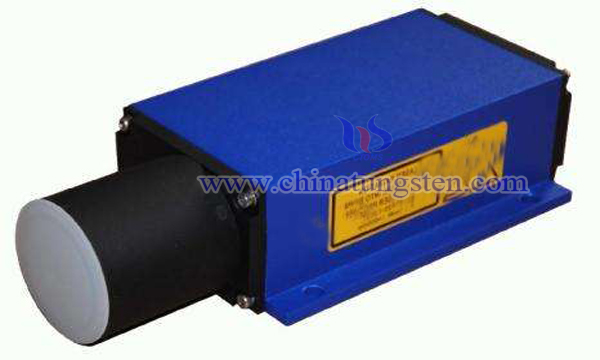Ammonia Gas Sensor for Diagnosis of Kidney Disease
- Details
- Category: Tungsten Information
- Published on Saturday, 03 August 2019 23:49
In the diagnosis of kidney disease, it is necessary to detect ammonia gas by breath analysis. Now the ammonia gas sensor used in human exhaled gas analysis and detection technology needs to face the complex environment of low gas concentration, many kinds of interfering gases, high concentration and high humidity. This requires that ammonia gas sensor has high sensitivity and small size. Due to the characteristics of cheapness, cheapness and on-line measurement, the sensitive materials used in ammonia gas sensor also need to have the characteristics of high sensitivity, high selectivity, high stability, simple preparation and low cost.

Tungsten trioxide can be used as sensitive material for ammonia gas sensor. However, the tungsten trioxide sensitive material used in ammonia gas sensor has poor selectivity and sensitivity to ammonia gas, which can not meet the needs of sensitive material used in modern human breath analysis technology for ammonia gas sensor. Requirements of sensitivity, high selectivity, high stability, simple preparation and low cost.
Tungsten trioxide can be used as sensitive material for ammonia gas sensor. However, at present, tungsten trioxide sensitive material used in ammonia gas sensor has poor selectivity and low sensitivity to ammonia gas, which can not meet the need of modern man-made nano WO3 structure with high sensitivity. In the existing technology, liquid phase synthesis is mostly used with water. Heat treatment, in this synthesis process, uses organic surface modifiers such as alcohols and organic acids. On the one hand, it increases the cost, difficulty and cycle of preparation of WO3 nanostructures; on the other hand, the organic substances used in the synthesis process are easy to remain on the surface of WO3 nanoparticles, which reduces its surface activity and thus reduces its response to gases.
In order to overcome this problem, the surface of nanostructured tungsten trioxide powder was catalytically modified with precious metals Au, Ru or Pd by impregnation method. The nanostructured tungsten trioxide gas sensitive material for surface catalytic modification of ammonia gas sensor was prepared. The specific verification steps include:
The first step is the preparation of carrier suspension: the sensitive materials used in ammonia gas sensor by volume expiration analysis technology need to have high sensitivity, high selectivity, high stability, simple preparation and low cost.
The carrier suspension was prepared by weighing 1g WO3 powder and 0.0305 g urea and adding 50 mL deionized water to form carrier solution. The carrier suspension was stirred by magnetic agitator for 0.5 hours and rotated at 400 rpm at 80 C.
The second step is the preparation of precious metal precursor solution.
The precious metal Au precursor solution was prepared by adding 0.0208g HAuCl4·3H2O with 48% mass fraction, 10 mL deionized water and stirring for 10 minutes at 30 C with a magnetic stirrer at 300 rpm/min.
Third step, preparation of WO3 precursor suspension modified by surface catalysis
The precious metal Au precursor solution prepared in the second step is injected into the glass burette. The carrier suspension prepared in the first step is put into the constant temperature water bath pot at 80 ℃. The magnetic agitator is used to stir the carrier suspension at a speed of 400 rpm/min. The glass droplets are dripped into the carrier suspension at a speed of 0.5 ml/min during the stirring process. The suspension product of WO3 precursor modified by catalysis was prepared by mixing the precious metal Au precursor solution in the fixed tube until the precious metal Au precursor solution in the glass burette was dripped out and kept stirring speed and temperature for 4 hours.
The fourth step is static aging at constant temperature.
The product of WO3 precursor suspension prepared by the third step was sealed and placed in a constant temperature water bath pot at 25 ℃ for 1 hour.
The fifth step, high speed centrifugation:
The fourth surface-catalyzed WO3 precursor suspension product to be used in the fourth step was placed in a centrifuge at 25 ℃, the rotation speed was set at 7000 rpm, and the liquid was separated after centrifugation for 10 minutes, and further, 150 mL of deionized water was injected. The above separation process was repeated three times to remove residual chloride ions, thereby preparing a surface-catalyzed modified WO3 precursor slurry product.
The sixth step, drying:
The prepared surface-catalyzed modified WO3 precursor slurry product was dried at 90 ℃ for 6 h under air to obtain a dried surface-catalyzed modified Au-WO3 powder containing crystal water;
The seventh step, high temperature sintering:
The obtained dried surface catalytically modified WO3 powder is placed in a muffle furnace, sintered at a temperature of 500 ℃ for 2 hours, and the water is discharged and naturally cooled to room temperature to obtain a surface-catalyzed modified Au-WO3 powder after sintering;
In the eighth step, the surface-catalyzed modified nanostructured WO3 sensitive material is prepared by grinding and sieving; the surface-catalyzed Au-WO3 powder obtained in the seventh step is placed in agate grinding, and after grinding for 10 minutes, the final system is prepared. The surface-catalyzed nanostructured Au-WO3 sensitive material is sealed and stored for use in an ammonia gas sensitive detector.
As a sensitive material for ammonia gas sensor, tungsten trioxide has undergone a process from pure WO3 powder to surface catalytic modification of nanostructured WO3 powder. Different noble metals (Au, Ru or Pd) were used to modify WO3 powder to improve the sensitivity of ammonia gas to meet the needs of disease diagnosis technology.
- Tungsten Oxide Manufacturer & Supplier, Chinatungsten Online: www.tungsten-oxide.com
- Tungsten News & Prices of China Tungsten Industry Association: www.ctia.com.cn
- Molybdenum News & Price: news.molybdenum.com.cn
- Tel.: 86 592 5129696; Fax: 86 592 5129797; Email: sales@chinatungsten.com



 sales@chinatungsten.com
sales@chinatungsten.com